Physical Address
304 North Cardinal St.
Dorchester Center, MA 02124
Functional tests such as stress electrocardiography (ECG), stress echocardiography, and stress nuclear perfusion imaging have limited accuracy for the detection of anatomic coronary artery disease but provide important prognostic information.
Normal functional testing, including exercise echocardiography and myocardial perfusion imaging (MPI), is associated with a low risk of cardiac events. The extent of stress-induced segmental wall motion and perfusion abnormalities helps to define which populations of patients will benefit most from revascularization and their incremental levels of risk.
Positron emission tomography (PET) is one of the most sensitive methods for the identification of viable myocardium. The detection of gadolinium-delayed enhancement by cardiac magnetic resonance (CMR) perfusion imaging is the most sensitive method for identifying scarred, nonviable myocardium.
A coronary computed tomography angiogram (CCTA) study that shows no coronary calcification or stenosis virtually excludes the presence of coronary artery disease (CAD).
Appropriate use of various imaging modalities depends on patient probability of disease, physician preference, and local imaging experience.
American College of Cardiology/American Heart Association guidelines are intended to provide a practical standard to individual clinicians and patients when considering one of these procedures, based on any number of important local and patient-specific variables, while promoting optimal test utilization for the population at large.
Noninvasive testing for myocardial ischemia in patients with known or suspected coronary artery disease (CAD) is conducted to establish the diagnosis of obstructive coronary atherosclerosis as the cause of symptoms, and to determine whether a patient would benefit from medical therapy and/or myocardial revascularization. Functional tests, such as stress electrocardiography (ECG), stress echocardiography, and stress scintigraphic myocardial perfusion imaging (MPI), attempt to quantify the degree of ischemia based on electrical, mechanical, and perfusion abnormalities. Over the last decade, coronary computed tomography angiogram (CCTA) has evolved as a noninvasive alternative to invasive coronary angiography for the direct evaluation of coronary anatomy. In general, anatomic tests, such as CCTA, have greater sensitivity for the detection of CAD, whereas functional tests have a greater ability to predict benefit from revascularization. This chapter provides an overview of the methodology and interpretation of these tests with the main objective of providing guidelines for appropriate test selection and treatment.
Angina in patients with obstructive CAD is caused by an imbalance between myocardial oxygen supply and demand. Asymptomatic patients with CAD have normal resting blood flow even in the presence of epicardial coronary artery stenosis as myocardial perfusion pressure and blood flow are maintained by compensatory dilation of the coronary arterioles. During stress, myocardial oxygen demand increases but myocardial blood flow does not increase proportionally, which leads to ischemia. The progressive metabolic and functional alterations that occur during ischemia, including electrical repolarization abnormalities and abnormal regional diastolic and systolic myocardial function, can be assessed by noninvasive testing. Stress may be accomplished by a number of methods that most commonly include exercise or pharmacologic agents. Whenever possible, exercise is the preferred stressor as the physiologic data obtained provides an assessment of a patient’s functional status, and provides valuable prognostic information. The choice between ECG, echocardiography, or MPI is often determined by local availability, costs, and individual patient characteristics. In general, specificity has been reported to be higher with stress echocardiography, and sensitivity is higher with MPI. Accordingly, many clinicians prefer stress echocardiography for individuals with a lower pretest probability of obstructive CAD, and MPI for those with a higher probability. Although exercise ECG has lower sensitivity and specificity than stress imaging modalities, it is cost effective and provides comparable prognostic information in patients who have a normal resting ECG and are able to exercise. One disadvantage of exercise ECG is that it cannot localize ischemia, which renders it less useful as a guide for targeting revascularization. Stress cardiac magnetic resonance (CMR) perfusion imaging provides both perfusion and wall motion information with accuracy comparable to stress MPI in addition to myocardial viability, and it is growing in use. Exercise and dobutamine stress CMR are also in clinical use, but are less common outside of larger centers. Over the last two decades, the prognostic utility of stress testing has been increasingly recognized. Exercise physiologic parameters, ECG abnormalities, and imaging findings including wall motion and perfusion abnormalities are powerful predictors of outcome.
Monitoring physiologic parameters during exercise such as heart rate, blood pressure, ventilatory capacity, and estimates of oxygen utilization help to define a patient’s functional capacity and to objectively evaluate for limiting clinical symptoms including angina and dyspnea. One of the most important parameters to evaluate is the metabolic equivalents (METs) achieved, which refers to oxygen uptake during activity; 1 MET is equivalent to 3.5 mL O 2 /kg/min of body weight and activities are estimated in multiples of METS. If a patient is able to jog at greater than 6 mph on level terrain, which would be approximately 10 METS, 20-year survival rates are significantly better than a patient who can only walk at 3 mph (3 METS). If exercise capacity is known to be excellent, this information may obviate the need for further data collection such as ECG and imaging tests. Patients with chronotropic incompetence during exercise stress testing also have worse outcomes independent of other factors. Chronotropic incompetence may be a marker of impaired autonomic dysfunction, which has been associated with angiographic severity of CAD and increased mortality. Heart rate recovery, calculated as the difference in heart rate at peak exercise versus 1 minute into recovery, is another index that is related to autonomic tone. A value below 12 beats/min (bpm) is considered abnormal. Patients evaluated for suspected or known CAD with an abnormal heart rate recovery have a markedly increased mortality rate independent of other risk factors. Although both impaired chronotropic response and heart rate recovery are powerful predictors of outcomes, it is unknown whether they are modifiable. Moreover, their association with mortality may be independent of the presence or severity of CAD.
Detection of ischemia by ECG stress testing relies on the development of abnormal repolarization that manifests as ST-segment depression during or immediately after exercise. Exercise ECG testing has modest diagnostic accuracy but remains a useful prognostic test. An index derived from the exercise ECG test that incorporates exercise time, magnitude of ST-segment deviation, and angina—known as the Duke treadmill score —has proven to be a powerful prognosticator of events. Exercise time is measured based on the Bruce protocol and appears to be the most important determinant of prognosis. The 5-year survival rates among patients categorized as low, intermediate, and high risk were initially reported at 97%, 91%, and 72%, respectively.
The interpretation of stress echocardiography is based on the identification of regional wall motion abnormalities induced by ischemia in the presence of obstructive CAD. The test has gained increasing acceptance following the introduction of digital acquisition, harmonic imaging, and contrast agents, all of which have incrementally contributed to improved image quality, reproducibility, and accuracy. In stress echocardiography, regional wall motion is assessed from parasternal and apical images using a 17-segment model of the left ventricle (LV). Each segment is described as either normal, hypokinetic, akinetic, or dyskinetic, and the results of the individual segments are averaged to calculate a global wall motion score. The diagnosis of CAD is based on the detection of either resting or stress-induced regional wall motion abnormalities ( Figs. 4.1–4.3 ). In most cases, a resting regional wall motion abnormality implies a prior myocardial infarction (MI), whereas a stress-induced regional wall motion abnormality implies ischemia caused by obstructive CAD.
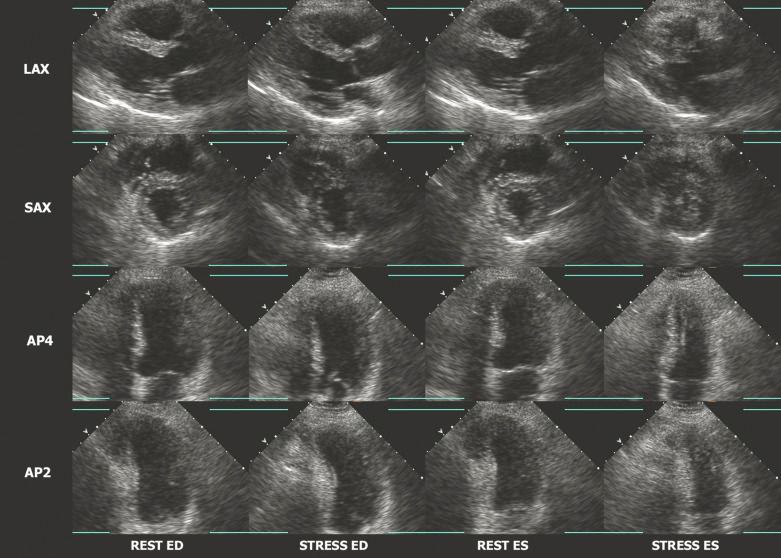
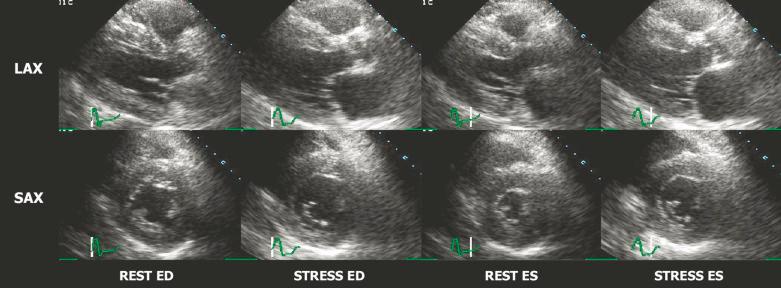
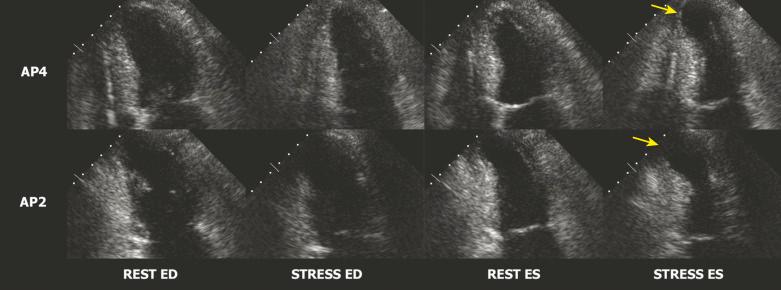
Exercise stress may be performed with a treadmill, a supine or prone bicycle, and even arm ergometry. Treadmill stress echocardiography is by far the most commonly used modality in the United States. Both treadmill and bicycle ergometry allow the evaluation of important functional data such as exercise capacity, blood pressure response, hemodynamic responses to exercise (including the assessment of cardiac output and pulmonary pressures), and standard ECG ST-segment analysis. Several studies have reported sensitivities that range from 71% to 97% and specificities ranging from 64% to over 90%. The sensitivity of exercise echocardiography is lower for the detection of single-vessel CAD, in particular in the circumflex coronary artery distribution. Quite often, ischemia is only detected in the territory supplied by the most stenotic vessel in those patients with multivessel disease, especially if the test is discontinued at a submaximal workload typically defined as achieving less than 85% of the age-predicted maximum heart rate.
Of note, resting and/or exercise-induced wall motion abnormalities may occur in patients with cardiomyopathies, microvascular coronary disease, severe hypertension (increased afterload), or valvular disease, and they are often a cause of false positive interpretations. Several stress echocardiographic variables have important prognostic value in patients with known or suspected CAD. A low exercise wall motion score or a fall in exercise ejection fraction is highly predictive of an increased risk of adverse cardiac events. The rate of cardiac events in individuals with a normal exercise echocardiogram has been reported in several studies to be less than 1% per year. ![]() , are an example of a typical exercise stress echocardiogram with resting, peak stress, and recovery views of the left ventricle from the long-axis, apical four-chamber (AP4), and apical three-chamber (AP3) views, suggestive of left main coronary artery disease or multivessel disease with corresponding coronary angiograms revealing diffuse coronary artery disease with a significant left main lesion.
, are an example of a typical exercise stress echocardiogram with resting, peak stress, and recovery views of the left ventricle from the long-axis, apical four-chamber (AP4), and apical three-chamber (AP3) views, suggestive of left main coronary artery disease or multivessel disease with corresponding coronary angiograms revealing diffuse coronary artery disease with a significant left main lesion.
Intravenous (IV) dobutamine, dipyridamole, or adenosine may be used as pharmacologic stressors with echocardiography. Dobutamine is the most commonly used stressor in the United States. It is administered by continuous infusion at incremental rates starting from 5 up to 50 μg/kg/min. It is often complemented by handgrip exercise and/or IV atropine (0.5 to 2.0 mg) to increase the heart rate. Dobutamine increases myocardial oxygen demand by increasing contractility and the heart rate. The reported sensitivity and specificity of dobutamine echocardiography for the detection of obstructive CAD are equivalent to those reported for exercise echocardiography. The sensitivity is reduced in patients with concentric hypertrophy who experience cavity obliteration early during the test, as well as in those who do not achieve the target heart rate. Echocardiographic variables obtained during pharmacologic stress have also been shown to have significant prognostic value. A normal dobutamine stress echocardiogram is associated with a low cardiac event rate while the presence of stress-induced regional wall motion abnormalities, particularly when detected at low heart rates, is a strong predictor of cardiac events. Low dose dobutamine stress echocardiography may be performed for risk assessment in patients after MI. In this setting, extensive resting regional wall motion abnormalities, stress-induced ischemia, absence of viability, and worsening LV ejection fraction (LVEF) with stress are associated with an increased risk of adverse events.
Adenosine and dipyridamole are used in many centers in Europe and South America, and they induce ischemia by creating a coronary steal in the setting of obstructive CAD, which can be assessed with the use of contrast agents. These agents consist of inert perfluorocarbon gases encapsulated in a biodegradable shell, which remain as microbubbles when injected. The microbubbles have a small enough diameter (<10 μm) to cross the pulmonary capillary bed and enter the systemic circulation. When they are exposed to ultrasound, they act as strong reflectors and allow better endocardial border visualization in addition to an assessment of myocardial perfusion. As the LV myocardium has a dense capillary bed, the injection of contrast microbubbles results in myocardial enhancement proportional to the myocardial blood volume allowing for myocardial contrast echocardiography (MCE) to be clinical useful. During vasodilator stress in the presence of a flow-limiting coronary stenosis, capillary blood flow and myocardial blood volume is reduced in the segments supplied by the stenotic vessel. This may be detected as either a delay in myocardial enhancement following contrast injection or a relative reduction in enhancement in ischemic compared with normal segments ( Fig. 4.4 ).
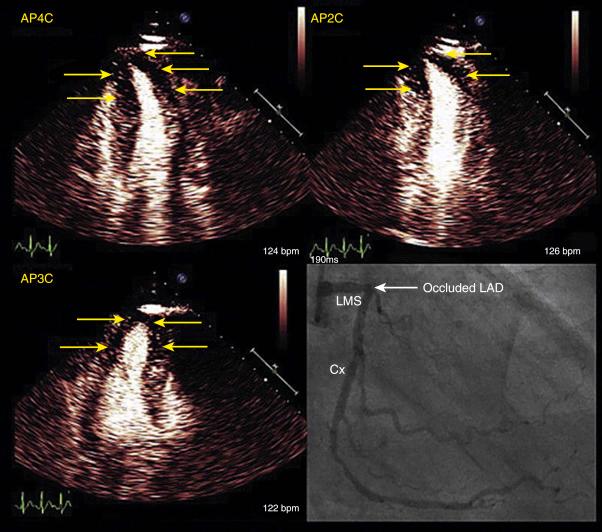
Although early studies demonstrated excellent sensitivity and specificity for MCE, subsequent multicenter trials did not. The first of these demonstrated a sensitivity that ranged from 63% to 75% for MCE versus 63% to 76% for single-photon emission computed tomography (SPECT) and specificity of 47% to 59% for MCE versus 53% to 76% for SPECT. The real-time assessment of myocardial perfusion (RAMP-1 and RAMP-2) trials studied a total of 662 patients and compared MCE to SPECT using coronary angiography as the gold standard. The overall accuracy of MCE was 66% to 71%, and it was noninferior to SPECT, with sensitivity that ranged from 50% to 77% and specificity that ranged from 55% to 88%. The largest multicenter trial to date enrolled 628 patients, comparing MCE with SPECT again with coronary angiography as the gold standard. Higher sensitivity was obtained with MCE than with SPECT (75.2% vs. 49.1%), but specificity was lower (52.4% vs. 80.6%) for coronary stenosis of 70% or greater. Sensitivity for the detection of single-vessel disease and proximal disease with 70% or greater stenosis was higher for MCE, which may, in part, be due to the higher sensitivity of contrast echocardiography for the detection of microvascular abnormalities. These studies suggest that MCE demonstrates superior sensitivity but lower specificity for the detection of CAD compared with SPECT in a population with a high incidence of cardiovascular (CV) risk factors and intermediate to high prevalence of CAD.
The assessment of MPI by nuclear scintigraphic methods relies on the administration of a radionuclide isotope that accumulates in the myocardium in proportion to myocardial blood flow during rest and stress. MPI is performed with either single-photon–emitting or dual-photon–emitting isotopes using SPECT or positron emission tomography (PET). Thallium-201, technetium-99m sestamibi, and technetium-99m tetrofosmin are isotopes commercially available for SPECT imaging. Currently, technetium-99m–based isotopes are preferred for their higher photon energy, which results in higher image quality, and their shorter half-life, which results in lower radiation exposure. In the past few years, there have been substantial advances in gamma camera technology. New SPECT systems replace the traditional Anger camera with individual cesium iodide (CsI) scintillation crystals coupled to solid-state photodiodes or novel semiconductor-based detectors using cadmium–zinc telluride (CZT). They eliminate the need for conventional crystal and photomultiplier tubes by directly converting gamma radiation to an electronic pulse. CZT systems are significantly smaller than the traditional sodium iodide detectors and have shown improved efficiency, which makes it possible to obtain higher counts, thus improving signal-to-noise ratio and spatial resolution without increasing isotope dose or acquisition time. The most obvious direct benefit to patients is reduced radiation exposure without a sacrifice in image quality or an increase in acquisition time. Several studies have been performed to compare these new solid-state cameras to those acquired by conventional gamma cameras. All of them found comparable MPI quality with the benefit of significantly shorter image acquisition times. Some of these studies also evaluated LVEF and volumes and reported similar results between the two.
PET imaging systems rely on the simultaneous detection of a pair of photons traveling in opposite directions. These photons travel toward detectors positioned around the subject, where they interact, become absorbed, and thus produce an electrical signal. The detector signals are processed by specialized coincidence circuitry. If the difference in the time of arrival of these photons is less than a predetermined value (typically <10 ns), a signal is recorded. Unlike SPECT imaging, PET imaging does not require collimation. Thus, the efficiency of PET is several magnitudes greater and provides higher resolution, lower noise, and lower radiation exposure.
With either SPECT or PET cardiac perfusion studies, images are obtained after stress and at rest. For segmentation of the left ventricle, a 17-segment model is applied. Images are interpreted visually or by using automated quantification based on normalized data. Myocardial scar is determined by the presence of a relative perfusion defect (compared with the segment with the highest counts), which persists on both stress and resting images. Ischemia is determined by the presence of a perfusion defect on stress images that improves or resolves on the resting images ( Figs. 4.5–4.8 ).
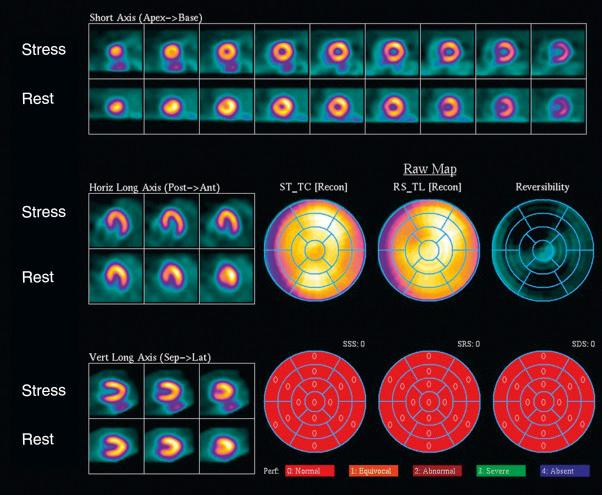
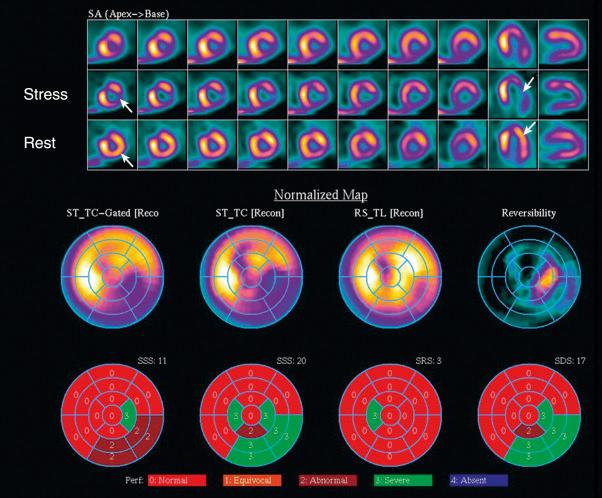
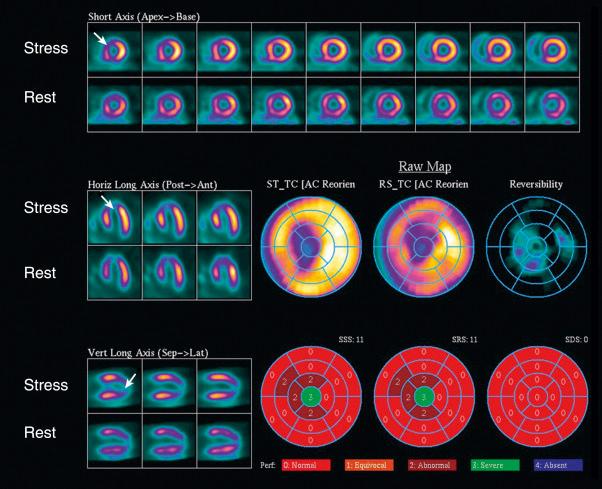
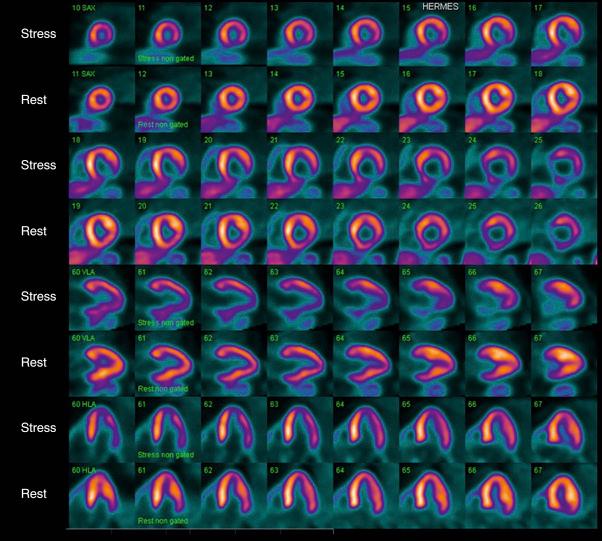
Become a Clinical Tree membership for Full access and enjoy Unlimited articles
If you are a member. Log in here